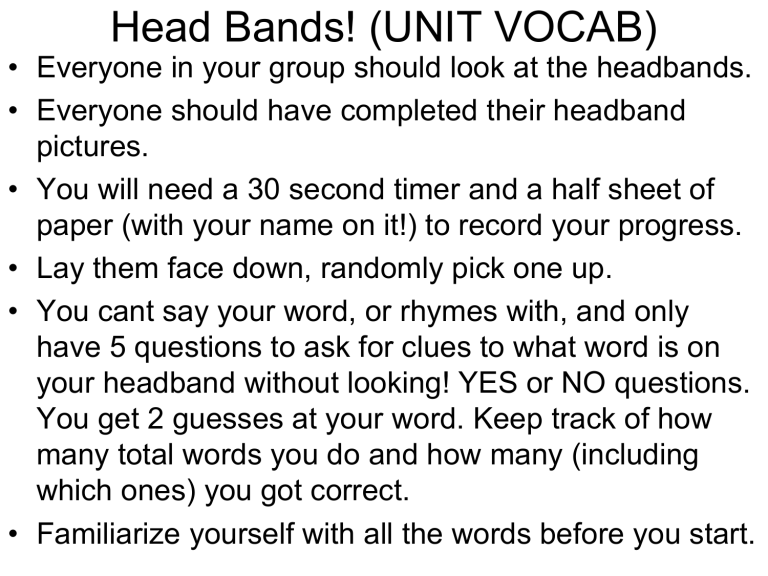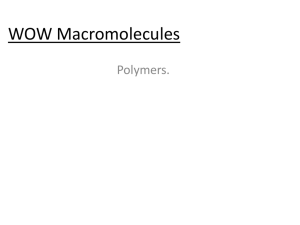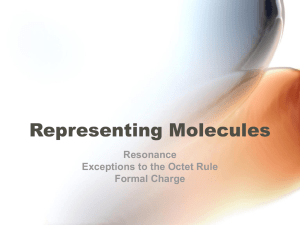CELLS! - Mr. McCabe

Head Bands! (UNIT VOCAB)
• Everyone in your group should look at the headbands.
• Everyone should have completed their headband pictures.
• You will need a 30 second timer and a half sheet of paper (with your name on it!) to record your progress.
• Lay them face down, randomly pick one up.
• You cant say your word, or rhymes with, and only have 5 questions to ask for clues to what word is on your headband without looking! YES or NO questions.
You get 2 guesses at your word. Keep track of how many total words you do and how many (including which ones) you got correct.
• Familiarize yourself with all the words before you start.
CH. 1 Cell Biology
Unit Vocabulary! (Left hand page!)
Macromolecule (4)
(1) Carbohydrate
Monosaccharide
(2) lipid
(3) protein enzyme
(4) nucleic acid
Nucleotide amino acid
(Cell energy) catalyst
(Type of cell)
Prokaryote (basic)
Eukaryote (advanced)
(Parts of cells animal/plant)
Endoplasmic reticulum (A/P)
Golgi apparatus (A/P)
Chloroplast (P) mitochondria (A/P)
HOMEWORK!
• Due tomorrow: Section ?’s and vocab (quiz on your reading)
• Due Friday – Cell Biology Cover Page. 4 pictures, COLOR!
• Friday – weekly quiz on homework
CH.1
Cell Biology
Standard 1a-h
New open entry
CH. 1 Cell Biology
Unit Vocabulary! (Left hand page!) macromolecule
Carbohydrate
Monosaccharide lipid protein amino acid nucleic acid
Nucleotide enzyme catalyst
Prokaryote
Eukaryote
Endoplasmic reticulum
Golgi apparatus
Chloroplast mitochondria
Function
CH. 1 Cell Biology
Top of page right hand page
Structure
CELLS
Homeostasis
Standard 1 CELL BIOLOGY
Cell Biology
(UNDER mind map)
Standard 1 CELL BIOLOGY
The fundamental life processes of plants and animals depend on a variety of Chemical reactions that occur in specialized areas of the organism’s cells.
4 pictures, 4 colors min. that have to do with Cell
Biology (remember your vocab!)
YEEHAW!!!
• You will need your notebook open to your daily questions
• You will need a ½ sheet of paper
(hamburger style), share the other with the person next to you for your reading quiz from last nights homework.
• Have a finger or paper in your homework so I can check!
Daily Question #10
1. Classify the following as a protein, nucleic acid, carbohydrate, or lipid: a.
Potato c. apple juice b.
DNA d. glucose e. beef jerky f. egg white g. whole milk h. egg yolk
2. Are saturated fats solid or liquid at room temperature?
3. Are unsaturated fats solid or liquid at room temperature?
4.
Which type of bond “shares” electrons but the electrons are unable to move?
5. What type of bond is produced between two charged particles (+/-).
6. Simple ________ like sugar, can be utilized for immediate energy needs. ______ on the other hand are more essential for long term energy storage.
Homework ch 3.1
•Left hand side ?’s on top, vocabulary on the bottom.
•?’s
•1. Draw a diagram and label the main parts of the atom.
•2. Name and describe the 3 types of bonds.
•3. Why is it essential to understand atoms behavior in order to understand cells behavior.
•Vocabulary - matter, atom, element, valence electrons, compound
• What are some defining characteristics of Life?
What is life?
• How can you tell if something is alive?
• Movement, sensitivity, development, complexity, death.
• Everything living is comprised of Cells.
• Cells are comprised of atoms, the building blocks of everything.
•Lets take a look back…
Atoms: the chemistry of life.
• Describe the structure of an atom.
• Structure of atoms
–Nucleus (P/N)
–electrons
• Valence electrons are those that are on the OUTSIDE shell.
•Shells can hold between 2-32
(2,8,18,32,32) electrons
•EVERY ATOM DESIRES TO
BE BALANCED! OR in a state of homeostasis .
Atoms: the chemistry of life.
• Why do Atoms
• Atoms form bonds to
STABILIZE, or create form bonds?
homeostasis.
• A chemical bond is the force that holds atoms or ions together.
Atoms: the chemistry of life.
•Describe the 3 types of bonds.
•METALLIC bonds
– Between two “metal” elements.
– SHARES electrons.
– (e-) move freely (electricity)
On your next open left hand page…
• Copy the chart that is on your desk, landscape
(sideways)
• You will have homework tonight with a quiz on the vocabulary and questions (10pts) tomorrow.
PAY ATTENTION! And study.
• You will have 8 minutes. Add color for full credit.
Homework! Ch. 3.4
• Remember homework goes on the Left hand sides of your notebooks, the EVEN pages.
• Vocabulary words that are important: energy , reactant , product , activation energy , enzyme , substrate , active site , metabolism .
• Questions 1,2,3,5 from book . Write in
COMPLETE sentences. Write the PAGE
NUMBER where you found the answer
(evidence) in order to receive full credit (on words too).
• Quiz tomorrow on reading/vocabulary.
METALLIC BOND
METALLIC BONDS form when any element in the METAL group bond with another element in the METAL group.
Metallic bonds are WAY better than M&M’s because they are M&M&M (Metallic bond = Metal + Metal) Get it?
Atoms: the chemistry of life.
•Distinguish between the 3 types of bonds.
• IONIC Bond
– the force that holds oppositely charged ions together.
•Metal ions are positive (cations)
•Nonmetal ions are negative
(cations)
•Any “salt”
IONIC BONDS form when any element in the METAL group bond with any other element in the NON-METAL group.
Since our bodies contain IONIC BONDS – I aM aN Ionic
Bond. Get it? IMN (Ionic Bond = Metal + Nonmetal)
Atoms: the chemistry of life.
•Distinguish between the 3 types of bonds.
• COVALENT Bond
–SHARE 1 or more electrons
(literally)
– e- share to gain a full outer shell (8). HOMEOSTASIS.
COVALENT BONDS form when any element in the NON-
METAL group bond with any other element in the NON-
METAL group.
Covalent Bonds made the news on CNN. Get it?
Covalent Bond = Nonmetal +Nonmetal.
Organic compounds are COVALENT BONDS!
Standard 1h
Students know most macromolecules
(polysaccharides, nucleic acids, proteins, lipids) in cells and organisms are synthesized from a small collection of simple precursors.
(all “standards” need to be highlighted in your book)
Atoms: the chemistry of life.
•What are organic molecules?
•What are macromolecules?
•What are the 4 main types of macromolecules.
•Organic Molecules are atoms with carbon
–Molecules = ?
•Macromolecules are 2 or more ORGANIC molecules bonded together.
– macromolecule = 1 or more molecule with carbon.
•There are 4 main types of macromolecules…
Carbohydrates
Proteins
Macromolecules
Lipids
Nucleic Acids
DNA
RNA
Organic Compounds (Macromolecules) include
Carbohydrates
That consist of..
Glucose(sugar) molecules. Mono (simple) is one chain, poly
(complex) = many chains
Function is:
Proteins
That consist of..
Chains of amino acids in a specific 3d shape for specific FUNCTION.
Function is:
1.Short term energy. 2.
Structural suppor. 3. Cell recognition.
Examples are:
Energy - sugar, glucose.
Structure- cellulose
(plants).
WORKHORSE! Proteins
= life.
Examples are:
Keratin - hair, nails.
Antibodies - kill invaders. Enzymes carryout biochemical reactions
Lipids
That consist of..
Fat, waxes, phoshpolipids, and steroids.
Function is:
1. Long term energy. 2.
Water barrier (philic, phobic)
Examples are:
Main purpose of fat is storage, more efficient than carbs. Barriers made of a BI-layer
Nucleic Acids
That consist of..
Nucleotides (3 parts: sugar, phosphate and nitrogen base)
Function is:
To provide
INSTRUCTIONS, or genetic code. To provide energy (ATP)
Examples are:
DNA, RNA located on in chromosomes in nucleus of your cells.
Energy = ATP
Extra notes… Extra notes… Extra notes… Extra notes…
Organic Molecules (macromolecules)
Carbohydrates
•Made of C, H, O in ratio of 1-2-1 (sugar)
ENERGY SOURCE !
•Can be simple (monosaccharide, sugar, quick energy), or complex (polysaccharide, starch, pasta/rice short term energy storage).
•Cellulose provides structural support, plants, becomes undigested fiber in humans.
•Cows/horses can break down cellulose for use. Termites
Organic Molecules (macromolecules)
Proteins
•WORKHORSE OF ALL LIFE!
•Composed of long chains of amino acids
•Proteins function determined by its 3D shape.
•Hemoglobin = protein in blood that transports
Oxygen
•Proteins provide structure: collagen = cartilage, tendons; keratin = hair.
•Proteins act as enzymes which increase chemical
Reactions needed for growth, movement etc.
Organic Molecules (macromolecules)
Lipids
• Fats
•INSOLUBLE (wont dissolve in water) Hydrophilic head, hydrophobic tail.
•Fats store energy , more carbon-hydrogen bonds than carbohydrates.
• Saturated fats –solid at room temp. Are “saturated” or
“hydrogenated” with hydrogen.
• Unsaturated fats =liquid at room temp. Olive oil, vegetable oil etc…
Organic Molecules (macromolecules)
Nucleic Acids
•Two main types: DNA, RNA. Sub units are called nucleotide s which form genes (A,C,G,T/U).
•DNA = double helix. It encodes sequence of proteins and when they should reproduce. Made of two RNA strands.
•DNA together with proteins called chromosomes.
•RNA (monomer of DNA)helps in the synthesis of proteins and carry DNA’s message from one place to another in a cell.
CELLS!
Standard 1c
Students know how prokaryotic cells, eukaryotic cells
(including those from plants and animals), and viruses differ in complexity and general structure.
•Main differences
•EUkaryote (has nuclEUs
•Describe the difference between prokaryotic cells, eukaryotic cells and viruses.
• HAS nucleus
• HAS nuclear membrane
•Has organelles
•Larger than Prokaryote
•Prokaryote
•has flagellum or cilia for movement.
•Enclosed in Capsule (protection)
•Nucleoid not contained.
•Lack organelles
•“primitive” cell
Organelles = “little organs” i.e. mitochondria, vacuole etc…
Cell Membrane
No organelles
Nuclear Membrane
Vacuole
(storage)
Eukaryotic Cell
Prokaryotic Cell
BOTH
Daily Questions #12
The following are test questions please write them down INCLUDING THE CHART !
Also write down your answer.
You must choose an answer even if you are wrong! GUESS if you have to! The slides will automatically change after 5 minutes, so work quickly.
These are individual questions NOT group questions. Treat them like a quiz.
Daily Questions #11
*1. Eukaryotic cells are differentiated from prokaryotic cells because eukaryotic cells a. are much smaller b. have permeable membranes c. have a higher rate of reproduction d. have nuclei
*2. Which molecule in plant cells first captures the radiant energy from sunlight?
a. glucose b. Carbon Dioxide c. chlorophyll d. adenosine triphosphate
*3.
Daily Questions #11
??
A well defined nuclear membrane
Has
Is surrounded by
Contains
A rigid coat of cellulose
DNA mitochondria chloroplasts
Which of these best completes this concept map?
a. An animal cell b. A prokaryotic cell c. A virus d. A plant cell
Daily Questions #11
*4. A cell from a heart muscle would probably have an unusually high proportion of a. lysosomes b. mitochondria c. mRNA d. Golgi bodies
*5. The red blood cell membrane allows water, oxygen, CO2 and glucose to pass through.
Other substances are blocked making this membrane a. perforated b. semi-permeable c. non-conductive d. permeable
Daily Questions #11
*1. Eukaryotic cells are differentiated from prokaryotic cells because eukaryotic cells a. are much smaller b. have permeable membranes c. have a higher rate of reproduction d. have nuclei
*2. Which molecule in plant cells first captures the radiant energy from sunlight?
a. glucose b. Carbon Dioxide c. chlorophyll d. adenosine triphosphate
*3.
Daily Questions #11
??
A well defined nuclear membrane
Has
Is surrounded by
Contains
A rigid coat of cellulose
DNA mitochondria chloroplasts
Which of these best completes this concept map?
a. An animal cell b. A prokaryotic cell c. A virus d. A plant cell
Daily Questions #11
*4. A cell from a heart muscle would probably have an unusually high proportion of a. lysosomes b. mitochondria c. mRNA d. Golgi bodies
*5. The red blood cell membrane allows water, oxygen, CO2 and glucose to pass through.
Other substances are blocked making this membrane a. perforated b. semi-permeable c. non-conductive d. permeable
Diversity of Cells Lab
• Check the timer, that is how much time you have left, it’s a Rally day.
• If you run into a question ASK ME, don’t guess.
• READ THE DIRECTIONS!!!
• Clean up your own slides when you are finished in the front/side sinks. BE CAREFUL. Dry completely.
• Onion cell: peel off a tiny piece of the shiny skin of an onion, or scrape knife sideways then smear on slide, 1 small drop of methylene blue or lugols solution and allow it to soak for a few seconds. Then carefully tip the cover slip on.
• Make sure the STAPH slide stays with your microscope but clean up everything else.
Macromolecules worksheet
• While you start your Macromolecules worksheet, have your notebook open for me to check your CELL picture from the internet.
• DO NOT BE COLORING IT NOW! It should be finished. If you are coloring it you will not get credit.
• Have your Eukaryotic/prokaryotic WS out, also your lab paper.
Macromolecules worksheet
• HW!!!
• Tues- Macro worksheet due, Ch. 7.1 (on left side of NB) vocab and ?’s 1, 2, 4. quiz on the vocab.
• Wed – Unit vocab quiz, ch. 7.2 (on the left had side of NB) vocab and ?’s 2, 3, 4, 5
• Thursday – animal, plant cell half sheet due, parts quiz.
• Friday – Unit vocab quiz 2 (average score)
CELL as a metaphor
•What did we miss?
• What do YOU think that part could be?
•Bring colored pencils, tomorrow you will create your
OWN cell as a metaphor poster.
•Start thinking of something UNIQUE to represent the
Cell as.
•I will put you in groups to work together to create something MAGICAL!








